Fishing Swimbaits For Bass
Swimbait Realism....Sweet!
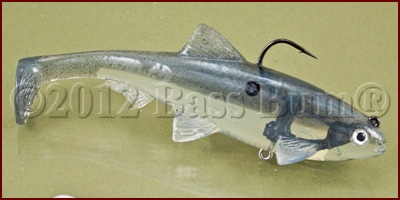
When you're fishing swimbaits you're fishing some of the most realistic, at least potentially, lures available to bass anglers today.
Real baitfish, such as shiners, shad and creek minnows and other forage like bluegill, crappie, frogs and lizards are never rejected by a bass "because they don't "look or act right". Perhaps a bass is not interested in one forage over another on any given day, just as we don't want pizza every day. However, they will always eat at least one "real" forage type when hungry.
So it's only logical to offer bass lures that look and mimic "real" forage as closely as possible. That's where one very successful lure type, "swimbaits", sometimes swim baits, come in. If you're fishing swimbait lures you're fishing a lure that walks the walk, so to speak. They look and act the part. But is that enough?
If a swimbait isn't the right size, rigged properly so it exhibits realistic action and also presented correctly old 'bucketmouth' or 'smalljaw' may take a good look, but they're likely to pass it by.
What About Swimbait Size?
Mega 8-12" Swimbait Lures
Yes, it's an established fact that large swimbait lures catch large bass. In keeping with this there are some real 10-12" monster soft and hard body swimbaits weighing as much as 8oz or more on the market, designed for catching those giant ten pound plus largemouth brutes found in California, Texas and Florida. But let's be real here, a great many of us don't fish in those states often, if at all.
If you're not expecting to catch a 10-25lb bass when fishing swimbaits don't waste your time and money with a mega swimbait.
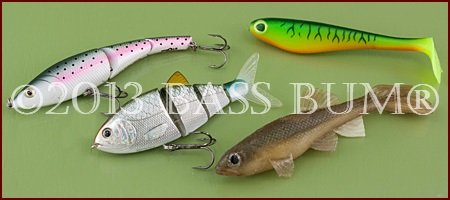
Regular 3-7" Swimbait Lures
For purposes of this discussion on swimbaits we'll focus on those bass swimbaits that are the most practical for the rest of us. We're speaking about swimbaits, both hollow and solid, in the 3-6" length. Those which are most suitable for the greatest number of us who fish other than in California, Texas or Florida. Don't think for a minute that a 6-7" swimbait is too small to tempt a 5-10lb largemouth or smallmouth.
If you intend on fishing swimbaits, deciding on a size of swimbait to fish requires first recognizing the maximum size bass you can realistically expect, or should I say hope, to catch where you fish. In most of the country, where the greatest number of us fish and where bass rarely exceed or even get close to that magic 10 pound size (despite our prayers), a swimbait that is 3-6" in length answers the call.
Within this length category fall the group known as "hollow body" or "hollow belly", soft swimbaits and a number that are solid body and "pre-rigged" with interior weights and treble hooks. The hollow body versions closely imitate slender baitfish but what about bluegill, crappie, stocked trout and even small bass? A five, six or seven pound bass will slurp up a 5" or 6" inch trout or bluegill every chance it gets so don't limit yourself to hollow body baitfish imitations. There are some great "solid" swimbaits that are 4-6" long and "ready to fish out of the package".

Hollow Body, Paddle Tail Swimbaits
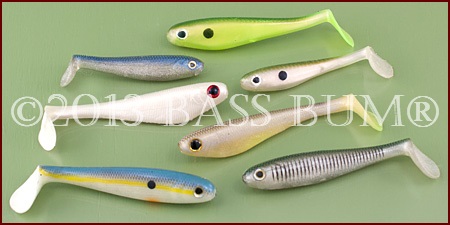
Correctly Rigging Hollow Body Swimbaits
Swimbait Hooks
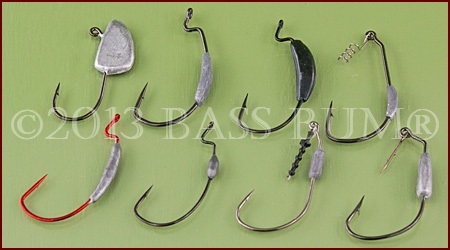
There are many different styles of hooks for hollow swimbaits. Most are variations on the basic "weighted offset" design. I've used many and most all work well if rigged correctly.

If you're fishing swimbaits, a hollow body swimbait that does not already have a "hook slot", like the YUM Money Minnow does, it's a good idea to cut open its belly in order to create a hook slot. Creating this slot will allow for easy hook insertion and alignment and further prevents damaging the lure's head, as would occur if you pushed the hook and its attached lead weight through the head. This slot also enables better hooksets because it reduces the amount of plastic the hook must penetrate with these thicker, larger plastic fishing baits.
How To Rig A Weighted Hook In Hollow Body Soft Plastic Swimbaits "Without A Hook Slot"

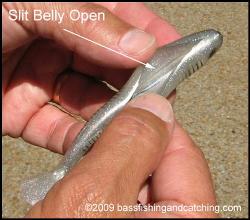
1. With scissors or knife, slice open the bait's belly evenly and down the center line.
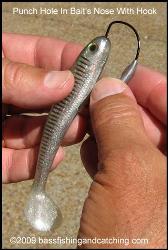 2. Next, push the point of your hook through the nose of the bait creating a path for the hook's eye to go through. |
 3. Take your hook and push its eye through the hole in the bait's head from inside the bait. |

4. Place the hook beside the body to determine the correct location through which its point should punch through the body. This will contribute greatly to the lure running true.
 5. Push the hook point through the body making sure you are exiting in the center line of the bait. This is very important! If you're off left or right the bait will not run true but leaning on its side and will not appear natural to bass. |
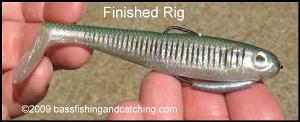 6. Skin hook the hook point to make the bait weedless. |
Solid Soft Body Swimbaits
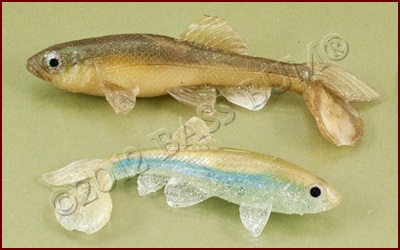 |
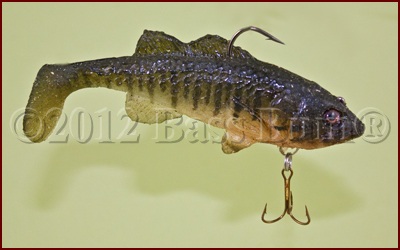 |
Though these "styles" of soft plastic swimbaits are available in longer versions the 5-6" versions are the models that will be used by most of us. They are also heavier than hollow bodies and require a heavier rod/reel combo to fish than hollow body paddle tails.
The swimbait lures shown in the photograph are some I have used with success and pleasure.
The Little Creeper swimbaits on the left above require rigging with an appropriate hook while the Matt Lures Baby Bass on the right comes ready to fish right out of the package with a single dorsal hook.
These baits are effective when you're fishing swimbaits past
laydowns, grass edges, brushpiles or submerged bush.
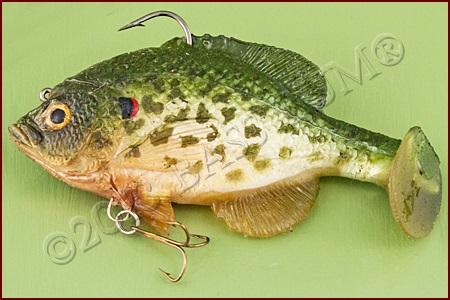
The bluegill can be dead-sticked on the bottom as it rests nose down as if eating eggs. These lures are also good for swimming "up" or jigging "up and down" sharp breaks on points or the side of flats.
Suggested Tackle - For this category of swimbaits I use a G. Loomis SWBR904C 7'6", medium-heavy, moderate-fast swimbait rod rated for 12-25lb line and swimbaits from 1/2-3oz. I combine this with a Shimano Calctta TE 201DC reel.
Hard Body Swimbaits
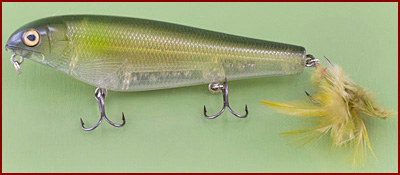 |
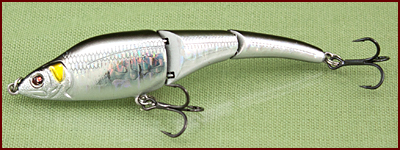 |
The Black Dog Lunker Punker, left above, and the Sebile swimbait shown right are but a few of many brands manufactured. They are shown here simply to illustrate the differences between soft and hard body swimbaits. Hard body swimbaits are sometimes "jointed".
When fishing swimbaits like these, jointed and 5-6" in length, I use both baitcasting and spinning gear I would normally use for equivalent size and weight crankbaits. I've not found a need for a technique specific swimbait rod with these lures.

Swimbait Presentations
It would be great if bass were always located relating to bottom structure or cover. Just get your bait down to them in their face and there is a good chance you'll get bit. Unfortunately, this is certainly not always the case as your sonar so clearly and so often illustrates. Bass are to be found high, low and in between in the water column. So, when fishing swimbaits you must adapt your rigging and presentation accordingly.
Number one thing to do is "match the hatch" when swimbait fishing!
Fishing Swimbaits In Shallow Water, 0-15'
- Slow and Steady - When bass are in 5-15' of water relating to cover be it docks, stump fields, laydowns or flooded bushes, fish a hollow body swimbait with a slow and steady retrieve. Don't overwork it. Keep it in the first five feet of water as you retrieve it. No need to twitch it, pause it or work it like a jerkbait. Adding a treble stinger hook when fishing shallow cover is likely to cause you headaches with hang ups. But then again, that's why they make lure retrievers.
- Change Direction - A contrary line of thought is that a "change in direction" or a "twitch or jerk" during the retrieve will entice a bass to strike. This is consistent with the fact that many bass, especially larger bass, will follow a swimbait for quite a distance before striking it. A sudden change in direction or a move upwards or downwards often stimulates an immediate strike.
Fishing Swimbaits On Points, 10-20'
- Uphill - Position yourself for fishing swimbaits on points to retrieve your lure "uphill" focusing on the area(s) with the sharpest break within the shortest distance, often at the end of the point. This is where bass naturally herd and corner baitfish before attacking. Use a heavy weighted hook, cast out and let your swimbait fall to the bottom. Bring your lure "up" the break slowly just off bottom moving it to the areas normally used by bass as kill zones for feeding.
- Lift and Drop - Vertically jig a swimbait along deep drops by lifting it 3-4' and then let it fall. Bass often attack forage on the fall.
- On The Shoreline - If bass aren't found working the breaks target the area where the point intersects the shoreline. Work your swimbait here as you would in shallow water.
Fishing Swimbaits In Deep Water, Greater Than 20'
- When fishing swimbaits in water that is 20-40' cast out a fast sinking swimbait and let it sink to the bottom. If the bottom is hard, without brush or vegetation, a treble stinger can be used. Jig or crawl the swimbait lure along the bottom.
- Deep structure often holds the biggest, wisest bass. Position your boat so you can cast past the structure then let the bait fall. Steadily retrieve it along side or even into the structure.
- When bass are suspended over deep cover like submerged trees cast out past or even into the middle of the cover then steadily retrieve the lure back to the boat.
Fishing Swimbaits On Underwater Humps
- As a hump is but an underwater island fish your swimbait as you would the many different features you would find on an above surface island. It has points, structure and cover. Fish them with your swimbait accordingly.
Fishing Swimbaits On Flats
- Slow-rolling - Bass will patrol the edges of flats searching out feeding opportunities. They focus on areas where the terrain changes from shallow to deep in the shortest distance, as with points. Fish your swimbait here the same as with points, slowly uphill, like slow-rolling a spinnerbait along the bottom. Stop them, let them sink for a brief moment, then resume your retrieve.
- Wormimg - Retrieve the swimbait as you might a worm, that is, let it hit bottom or the tops of grass on the break lines. Bounce it off the bottom with a stop and go action.
Return to Bass Fishing Techniques from Fishing Swimbaits
